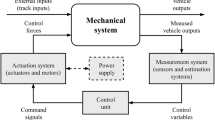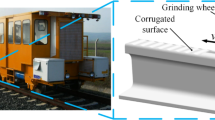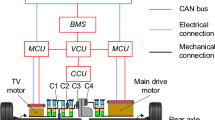Abstract
In this study, a new type of direct-drive pump-controlled hydraulic actuator is proposed for wet dual clutch transmission. The hierarchical control of the vehicle starting process was investigated based on this new hydraulic actuator. First, a starting intention recogniser was constructed through support vector machine to recognise the driver’s starting intention in real time. Subsequently, the hierarchical control of the starting process was divided into the planning and actuator control layers. The planning layer considered jerk, starting time, and friction work as optimisation objectives to plan the reference trajectory for the actuator control layer, in which an improved constant torque control strategy was used for the engine and an infinite time linear quadratic optimal controller was designed for the clutch. Finally, in view of the nonlinear characteristics of the direct-drive pump-controlled actuator, a linear active disturbance rejection control technique was employed to obtain real-time tracking of the reference trajectory. The simulation results showed that the engine–clutch cooperative control strategy can achieve less jerk and friction loss than the conventional starting control strategy under the premise of ensuring the starting time; moreover, LADRC showed excellent tracking performance and robustness.






























Similar content being viewed by others
References
Kim S, Oh JJ, Choi SB (2018) Driveline torque estimations for a ground vehicle with dual-clutch transmission. IEEE Trans Veh Technol 67(3):1977–1989
Kim S, Oh JJ, Choi SB (2017) Gear shift control of a dual-clutch transmission using optimal control allocation. Mech Mach Theory 113:109–125
Zhang Y, Chen X, Zhang X, Tobler W, Jiang H (2003) Dynamic modeling of a dual-clutch automated lay-shaft transmission. In: ASME international design engineering technical conferences and computers and information in engineering conference 37025:703-708
Kulkarni M, Shim T, Zhang Y (2007) Shift dynamics and control of dual-clutch transmissions. Mech Mach Theory 42(2):168–182
Van Berkel K, Hofman T, Serrarens A, Steinbuch M (2014) Fast and smooth clutch engagement control for dual-clutch transmissions. Control Eng Pract 22:57–68
Zhao ZG, Chen HJ, Yang YY, He L (2015) Torque coordinating robust control of shifting process for dry dual clutch transmission equipped in a hybrid car. Veh Syst Dyn 53(9):1269–1295
Zhao ZG, Lei D, Chen JY, Li HY (2018) Optimal control of mode transition for four-wheel-drive hybrid electric vehicle with dry dual-clutch transmission. Mech Syst Signal Pr 105:68–89
Zhou X, Walker P, Zhang N, Zhu B, Ruan J (2014) Numerical and experimental investigation of drag torque in a two-speed dual clutch transmission. Mech Mach Theory 79:46–63
Jung S, Kim J, Lee H, Ko Y, Choi S (2019) Hydraulic clutch fill control using control-oriented model in wet dual clutch transmission. In: 2019 American control conference (ACC) IEEE pp 5538–5543
Wu GQ, Si JY (2012) Launching intelligent control strategy for dual clutch transmission. J Tongji Univ 40(1):81–87
Lu T, Dai F, Zhang J, Wu M (2012) Optimal control of dry clutch engagement based on the driver’s starting intentions. Proc Inst Mech Eng Part D J Aut Eng 226(8):1048–1057
Dai F, Zhang JW, Lu TL (2012) Modelling and recognition of a driver’s starting intentions. Proc Inst Mech Eng Part D J Aut Eng 226(5):623–633
Li L, Zhu Z, Wang X, Yang Y, Yang C, Song J (2016) Identification of a driver’s starting intention based on an artificial neural network for vehicles equipped with an automated manual transmission. Proc Inst Mech Eng Part D J Aut Eng 230(10):1417–1429
Glielmo L, Vasca F (2000) Optimal control of dry clutch engagement. SAE Trans 109:1233–1239
Dolcini P, Béchart H, de Wit CC (2006) Observer-based optimal control of dry clutch engagement. In: Proceedings of the 44th IEEE conference on decision and control IEEE 440–445
Xie X, Wang X, Zhang X, Yu T (2008) Fuzzy control of clutch for automatic mechanical transmission vehicle starting. In: 2008 IEEE vehicle power and propulsion conference IEEE 1–4
Lu X, Wang P, Gao B, Chen H (2011) Model predictive control of AMT clutch during start-up process. In: Chinese control and decision conference (CCDC) IEEE 3204–3209
Zhao Z, He L, Zheng Z, Yang Y, Wu C (2016) Self-adaptive optimal control of dry dual clutch transmission (DCT) during starting process. Mech Syst Signal Pr 68:504–522
Balau AE, Caruntu CF, Lazar C (2011) Simulation and control of an electro-hydraulic actuated clutch. Mech Syst Signal Pr 25(6):1911–1922
Pinte G, Depraetere B, Symens W, Swevers J, Sas P (2010) Iterative learning control for the filling of wet clutches. Mech Syst Signal Pr 24(7):1924–1937
Hao H, Lu T, Zhang J, Zhou B (2016) A new control strategy of the filling phase for wet dual clutch transmission. Proc Inst Mech Eng Part C J Mech Eng Sci 230(12):2013–2027
Meng F, Zhang H, Cao D, Chen H (2016) System modeling and pressure control of a clutch actuator for heavy-duty automatic transmission systems. IEEE Trans Veh Technol 65(7):4865–4874
Wang S, Liu Y, Wang Z, Dong P, Cheng Y, Xu X, Tenberge P (2019) Adaptive fuzzy iterative control strategy for the wet-clutch filling of automatic transmission. Mech Syst Signal Pr 130:164–182
Ma K, Sun D, Sun G, Kan Y, Shi J (2020) Design and efficiency analysis of wet dual clutch transmission decentralised pump-controlled hydraulic system. Mech Mach Theory 154:104003
Walker PD, Zhang N (2013) Modelling of dual clutch transmission equipped powertrains for shift transient simulations. Mech Mach Theory 60:47–59
Garofalo F, Glielmo L, Iannelli L, Vasca F (2002) Optimal tracking for automotive dry clutch engagement. IFAC World Congr 35(1):367–372
Garofalo F, Glielmo L, Iannelli L, Vasca F (2001) Smooth engagement for automotive dry clutch. In: Proceedings of the 40th IEEE conference on decision and control IEEE 1:529–534
Lei YL, Ge AL, Li YJ (2000) Clutch Control Strategy in Starting Process. Aut Eng 22(4):266–269
Sun DY, Qin DT (2003) Clutch starting control with a constant engine speed in part process for a car. Chin J Mech Eng 39(11):108–112
Bryson AE, Ho YC (1981) Applied optimal control. Routledge, Hemisphere Washington D. C
Jung S, Choi SB, Kim J, Ko Y, Lee H (2020) Adaptive feed-forward control of the clutch filling phase for wet dual clutch transmission. IEEE Trans Veh Technol 69(9):9577–9588
Yang HY, Feng B, Gong GF (2011) Measurement of effective fluid bulk modulus in hydraulic system. J Dyn Syst-T ASME 133(6):061021
Yu JH, Chen ZN, Lu YZ (1994) The variation of oil effective bulk modulus with pressure in hydraulic systems. J Dyn Syst-T ASME 116(1):146–150
Gholizadeh H, Burton R, Schoenau G (2012) Fluid bulk modulus: comparison of low pressure models. Int J Fluid Power 13(1):7–16
Tang DL, Wu F, Jia PY, Zeng ZC (2017) Research on theoretical model for effective bulk modulus of air-liquid mixtures of hydraulic oil. China Mech Eng 28(3):300–304
Guo W, Liu Y, Zhang J, Xu X (2014) Dynamic analysis and control of the clutch filling process in clutch-to-clutch transmissions. Math Probl Eng 2014:1–14
Han JQ (2009) From PID to active disturbance rejection control. IEEE Trans Ind Electron 56(3):900–906
Han JQ (2008) Active disturbance rejection control technique – the technique for estimating and compensating the uncertainties. National Defense Industry Press, Beijing
Jin HY, Chen Y, Lan WY (2019) Replacing PI control with first-order linear ADRC. In: 2019 IEEE 8th data driven control and learning systems conference (DDCLS) IEEE 1097–1101
Li XY, Gao ZQ (2020) The invariance principle in disturbance rejection control. Control Theory Appl 37(2):236–244
Liu CQ, Luo GZ, Chen Z, Tu WC (2020) Measurement delay compensated LADRC based current controller design for PMSM drives with a simple parameter tuning method. ISA T 101:482–492
Zhang R, Han JQ (2000) Parameter identification by model compensation auto disturbance rejection controller. Control Theory Appl 17(1):79–81
Gao ZQ (2003) Scaling and bandwidth-parameterization based controller-tuning. In: 2003 American control conference, 6:4989–4996
Acknowledgements
This work has been supported by The State Key Laboratory of Mechanical Transmission, Chongqing University, China; the financial support of this work by the National Natural Science Foundation of China (grant no. U1764259).
Funding
National natural science foundation of china,U1764259, Datong Qin.
Author information
Authors and Affiliations
Corresponding author
Additional information
Technical Editor: Wallace Moreira Bessa.
Publisher's Note
Springer Nature remains neutral with regard to jurisdictional claims in published maps and institutional affiliations.
Appendices
Appendix A: Simulation parameters of the vehicle and DCT
Parameters | Units | Value |
|---|---|---|
Vehicle mass | kg | 1995 |
Tire radius | m | 0.36 |
Rolling resistance coefficient | — | 0.018 |
Vehicle frontal area | m2 | 2.6 |
Aerodynamic force coefficient | – | 0.36 |
Slope angle | – | 0 |
Density of the air | kg/m3 | 1.225 |
Gear ratio | – | 4.214 |
Final differential ratio | – | 3.944 |
Inertia moment of the engine | kg·m2 | 0.187 |
Equivalent inertia of the clutch driven plate | kg·m2 | 1.0087 |
Damping coefficient of the engine | Nm·s/rad | 0.06 |
Equivalent damping of the clutch driven plate | Nm·s/rad | 0.08 |
Static friction coefficient | – | 0.13 |
Dynamic friction coefficient | – | 0.11 |
Outer radius friction plate | mm | 96.25 |
Inner radius friction plate | mm | 82.35 |
Number of friction surfaces | – | 6 |
Appendix B: Parameters used in the simulation
Parameters | Units | Value |
|---|---|---|
Cross-sectional area of the clutch piston | m2 | 0.0046 |
Return spring stiffness | Nm/rad | 1.38 × 105 |
Idle stroke | mm | 3 |
Total volume of the clutch chamber and the oil supply line | m3 | 2.83 × 10–5 |
Displacement of hydraulic pump | ml/rev | 1.6 |
Leakage coefficient | m3/pa·s | 1.5 × 10–11 |
Rights and permissions
Springer Nature or its licensor holds exclusive rights to this article under a publishing agreement with the author(s) or other rightsholder(s); author self-archiving of the accepted manuscript version of this article is solely governed by the terms of such publishing agreement and applicable law.
About this article
Cite this article
Ma, K., Sun, D., Wang, D. et al. Hierarchical control of starting process for wet dual clutch transmission based on direct-drive pump-controlled hydraulic actuator. J Braz. Soc. Mech. Sci. Eng. 44, 426 (2022). https://doi.org/10.1007/s40430-022-03721-6
Received:
Accepted:
Published:
DOI: https://doi.org/10.1007/s40430-022-03721-6




